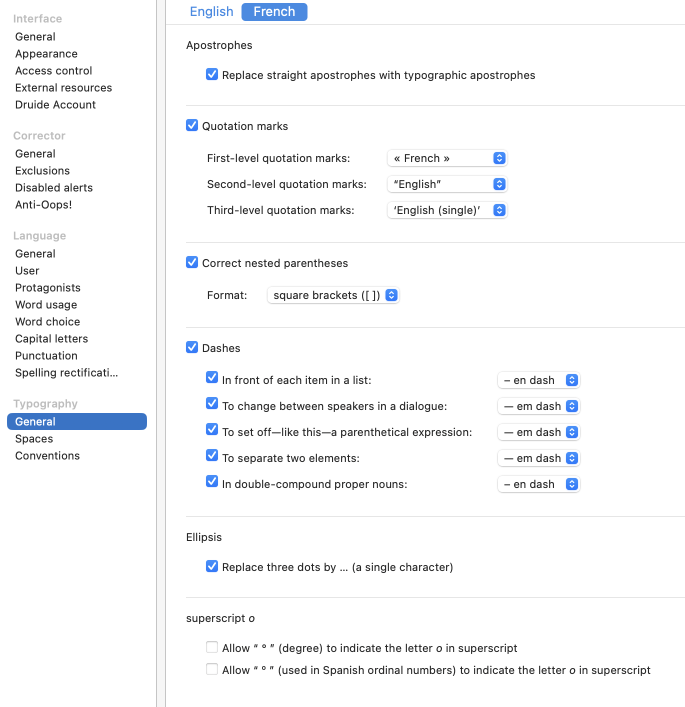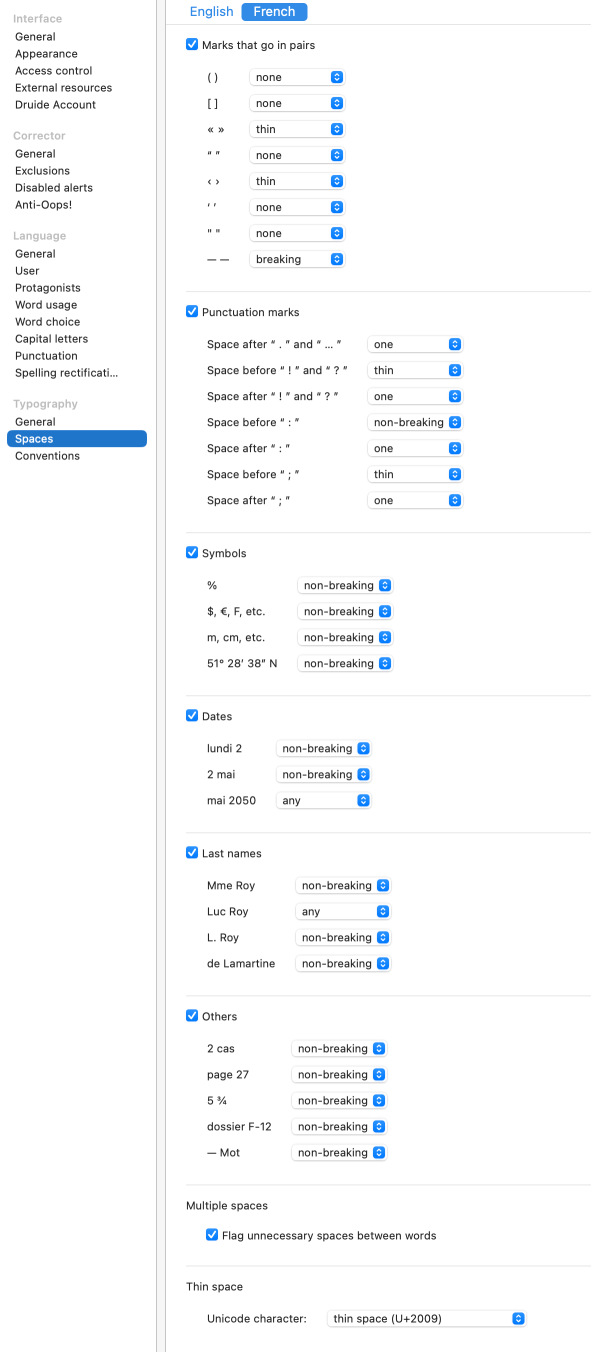Typography Settings for French
General panel

Quotation marks
If this box is checked, Antidote will correct the type of quotation marks used at different levels of quotation according to the settings you define. Standard typographic conventions call for French quotation marks (« ») in all contexts, except when the quotes are nested within other quotations. Double English quotation marks (“ ”) are recommended for the second level of nested quotes, and single quotation marks (‘ ’) are recommended for the third level, e.g. « Nous l’appelions “le ‘petit’ prince” quand il était enfant », se souvint-elle. Otherwise, you can tell the corrector to allow the punctuation you prefer for each level by choosing from:
- Double French quotation marks (« »)
- Double English quotation marks (“ ”)
- Single French quotation marks (‹ ›)
- Single English quotation marks (‘ ’)
- Straight quotation marks (" ")
- Any type of quotation mark
- This setting is enabled and standard French conventions are applied by default.
- Uncheck the box to completely disable detections related to the style of quotation marks used in French.
Dashes
If this box is checked, Antidote will correct the use of dashes, allowing you to choose your preferred type of dash in any of the following contexts: In front of each item in a list, To change between speakers in a dialogue, To set off a parenthetical expression, To separate two elements and In double-compound proper nouns (e.g. Nord–Pas-de-Calais).
Superscript o
If the Allow “ ° ” (degree) to indicate the letter o in superscript box is checked, Antidote will allow the degree symbol where normally a superscript o would be required, e.g. in the abbreviation no (for numéro).
If the Allow “ ° ” (used in Spanish ordinal numbers) to indicate the letter o in superscript box is checked, Antidote will allow the Spanish ordinal symbol where normally a superscript o would be required, e.g. in the abbreviation no (for numéro).
Spaces panel

Marks that go in pairs
If this box is checked, Antidote will correct spacing errors around paired symbols, according to the individual settings you choose for each of the following: (), [], « », “ ”, ‹ ›, ‘ ’, " ",——. For each paired symbol, you may choose either a breaking space, a non-breaking space, a thin space, any space or none at all.
Punctuation marks
If this box is checked, spacing errors around punctuation marks are corrected, according to the individual setting you chose for the period, ellipsis, exclamation mark, question mark, colon and semicolon. Following the period, the ellipsis, the exclamation mark, the question mark, the semicolon and the colon, you may choose from one space, two spaces or any number of spaces. Before the exclamation mark, the question mark, the colon and the semicolon, you may choose either a breaking space, a non-breaking space, a thin space, any space or none at all.
Symbols
If this box is checked, Antidote will correct the use of spaces around symbols, allowing you to choose the type of space to use for the following types of symbols: %; $, €, F, etc.; m, cm, etc.; and 51° 28′ 38″ N. Depending on the type of symbol, you may choose either a breaking space, a non-breaking space, a thin space, any space or none at all.
Dates
If this box is checked, Antidote will correct the use of spaces in dates, allowing you to choose the type of space to use in the following date formats: lundi 2, 2 mai and mai 2050. In all cases, you may choose either a breaking space, a non-breaking space, a thin space or any space.
Last names
If this box is checked, Antidote will correct the use of spaces in last names, allowing you to choose the type of space to use in the following types of names: Mme Roy, Luc Roy, L. Roy and de Lamartine. In all cases, you may choose either a breaking space, a non-breaking space, a thin space or any space.
Others
If this box is checked, Antidote will enforce your choice of spacing in a number of precise contexts. Depending on the case, you may choose a breaking space, a non-breaking space, a thin space, any space or none at all.
Conventions panel

The settings for the French Conventions panel work in the same way their English counterparts, but are managed separately to allow for different conventions in the two languages. Standard formatting conventions for times, numbers, addresses and phone numbers in French are quite different from those of English. The French settings also allow for non-standard currency symbols to be accepted by the corrector.